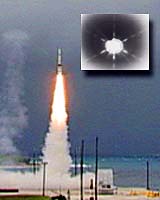| . |  |
. |
|
by Jim Mannion  Washington (AFP) January 19, 2000 - A US interceptor missile failed in an attempt to hit a target missile over the Pacific Tuesday in a setback for the Pentagon's controversial national missile defense system, a Pentagon spokeswoman said.
Washington (AFP) January 19, 2000 - A US interceptor missile failed in an attempt to hit a target missile over the Pacific Tuesday in a setback for the Pentagon's controversial national missile defense system, a Pentagon spokeswoman said.A modified Minuteman II intercontinental ballistic missile was launched at 6:19 p.m. local time Tuesday (0219 GMT Wednesday) from Vandenberg Air Force Base in California and an interceptor missiles was fired from Kwajalein atoll about 20 minutes later, she said. "The intercept was not achieved," said Cheryl Irwin, the spokeswoman. The reason for the failure may not be known for several weeks when a team of government and industry official completes an extensive review of the test results, she said. The miss follows a successful interception on the first try October 2. But Tuesday's test was more ambitious: the interceptor missile was supposed to be guided with real-time radar and satellite data from a battle management command center at Kwajalein in the Marshall Islands. The outcome was closely watched because US President Bill Clinton is supposed to decide this summer whether to go ahead with the deployment of the system by 2005 to counter a missile threat from rogue states. Two "metal-on-metal" hits, one of them being an integrated test of the system, is the minimum criteria set by the Pentagon for recommending deployment of the system. The test failure will give ammunition to NMD opponents who question the technical feasibility of a national missile defense system and argue that it is not worth the risk of damaging existing arms controls regimes. The system is designed to protect all 50 US states against a limited attack by ballistic missiles fired by rogue states. Proposals under consideration by the Pentagon call for an initial deployment of 100 interceptors in Alaska oriented toward North Korea, considered the most pressing threat. That would require either changing or scrapping altogether the 1972 Anti-Ballistic Missile with Russia, which vehemently opposes a US missile shield. US allies in Europe also are worried that the system will undercut deterrence and undermine nuclear arms control regimes. But Defense Secretary William Cohen, who last year sharply increased the budget for national missile defense to 10.5 billion dollars, this year plans to raise it another 2.2 billion dollars to include possible deployment costs, Pentagon spokesman Kenneth Bacon said. The latest test involved an intricate, high speed interplay of satellites, radars and computerized command centers to detect, track and destroy the target missile fired from California. It called for early warning satellites to pick up the flare of the launch and relay data on the missile trajectory, velocity and predicted point of impact to a command center in Colorado Springs. Colorado Springs was then to cue a radar in Hawaii to track the missile's flight. A surrogate of the advance X-Band radars being developed for the national missile defense system, the Hawaii radar was supplemented with degraded GPS data from the target missile to mimic the more advanced radar. Data from the radar and satellites were then to be relayed to the battle management command center in Kwajalein, the computerized brains of the operation. The Kwajalein command center was to order the launch of the interceptor missile. An "exoatmospheric kill vehicle" atop the missile was supposed to separate about 2.5 minutes later and maneuver into an intercept basket more than 120 miles (190 kilometers) above the earth. The kill vehicle is designed to search for a dummy warhead released by the target while closing in at a speed of 15,000 kilometers (9,300 miles) per hour. Upon finding it, it should then move into a collision course with the warhead to destroy it. Copyright 1999 AFP. All rights reserved. The material on this page is provided by AFP and may not be published, broadcast, rewritten or redistributed.
MILSPACE
Missile Defense at SpaceDaily
|
| |||||||||
| The content herein, unless otherwise known to be public domain, are Copyright 1995-2016 - Space Media Network. All websites are published in Australia and are solely subject to Australian law and governed by Fair Use principals for news reporting and research purposes. AFP, UPI and IANS news wire stories are copyright Agence France-Presse, United Press International and Indo-Asia News Service. ESA news reports are copyright European Space Agency. All NASA sourced material is public domain. Additional copyrights may apply in whole or part to other bona fide parties. Advertising does not imply endorsement, agreement or approval of any opinions, statements or information provided by Space Media Network on any Web page published or hosted by Space Media Network. Privacy Statement All images and articles appearing on Space Media Network have been edited or digitally altered in some way. Any requests to remove copyright material will be acted upon in a timely and appropriate manner. Any attempt to extort money from Space Media Network will be ignored and reported to Australian Law Enforcement Agencies as a potential case of financial fraud involving the use of a telephonic carriage device or postal service. |